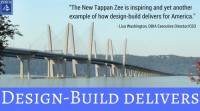You don’t have to be a New Yorker to appreciate the engineering, design, construction and political marvel that is the new Tappan Zee bridge. Dubbed the “$4 Billion Marvel” by The New York Times, the impressive bridge project hosts its first drivers this weekend:
“The new bridge is a symphony of statistics. More than 1,000 cylindrical piles were planted into the Hudson riverbed to create 41 pillars to hold up each span. Some 330,000 cubic yards of concrete were poured in construction, including some 6,000 precast concrete road deck panels. The main decks of both spans are held up by 192 cables stretched among eight 419-foot angled towers. The bridge will handle 140,000 cars a day.”
None of this could have happened without design-build.
“New York’s Tappan Zee Bridge has been the poster child for America’s failing infrastructure and the challenges we face as a nation in repairing and maintaining our vital roads, waterways and bridges. After decades of delay and millions of dollars spent for naught, the bridge crumbled before our eyes. However, that all changed with the passage of design-build legislation in New York. Thanks to the cost and time efficiencies central to the design-build delivery system, this weekend New Yorkers can try out the first new span of the new Tappan Zee bridge and celebrate a new infrastructure renaissance in their state.
It’s impossible to understate the vital role design-build plays in New York’s new infrastructure era. From Newark and LaGuardia Airports to the Goethals, Kosciuszko and Tappan Zee Bridges, design-build has saved the state billions of dollars and many years in project delivery time. The Tappan Zee alone came in $1 billion less than what the state had projected it would cost. Design-build delivers in New York. Imagine what other state agencies and the City could do if granted full design-build authority?”…Lisa Washington, DBIA Executive Director/CEO
Not only can we imagine it…we will make it happen. DBIA will continue to work with lawmakers in Albany to bring design-build to all state agencies and the City so that they too can benefit from the time and cost savings already seen under New York’s limited authority.

